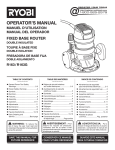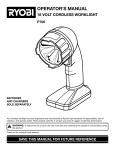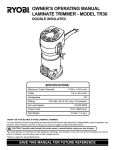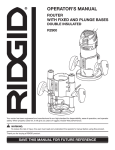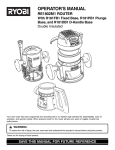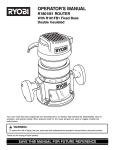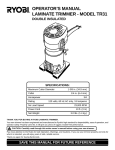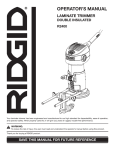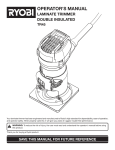Download Ryobi r163 Operator`s manual
Transcript
OPERATOR’S MANUAL FIXED BASE ROUTER DOUBLE INSULATED R163 Your router has been engineered and manufactured to our high standard for dependability, ease of operation, and operator safety. When properly cared for, it will give you years of rugged, trouble-free performance. WARNING: To reduce the risk of injury, the user must read and understand the operator's manual before using this product. Thank you for your purchase. SAVE THIS MANUAL FOR FUTURE REFERENCE TABLE OF CONTENTS Introduction...................................................................................................................................................................... 2 Warranty........................................................................................................................................................................... 2 General Safety Rules..................................................................................................................................................... 3-4 Specific Safety Rules........................................................................................................................................................ 4 Symbols......................................................................................................................................................................... 5-6 Electrical........................................................................................................................................................................... 7 Features......................................................................................................................................................................... 8-9 Assembly.......................................................................................................................................................................... 9 Operation................................................................................................................................................................... 10-18 Adjustments.................................................................................................................................................................... 18 Maintenance................................................................................................................................................................... 19 Accessories.................................................................................................................................................................... 19 Parts Ordering / Service................................................................................................................................................. 20 INTRODUCTION This tool has many features for making its use more pleasant and enjoyable. Safety, performance, and dependability have been given top priority in the design of this product making it easy to maintain and operate. warranty RYOBI® POWER TOOL - LIMITED TWO YEAR WARRANTY AND 30 DAY EXCHANGE POLICY One World Technologies, Inc., warrants its RYOBI® power tools with the following conditions: 30-DAY EXCHANGE POLICY: During the first 30 days after date of purchase, you may either request service under this warranty or you may exchange any RYOBI® power tool which does not work properly due to defective workmanship or materials by returning the power tool to the dealer from which it was purchased. To receive a replacement power tool or requested warranty service, you must present proof of purchase and return all original equipment packaged with the original product. The replacement power tool will be covered by the limited warranty for the balance of the two year period from the date of the original purchase. WHAT THIS WARRANTY COVERS: This warranty covers all defects in workmanship or materials in your RYOBI® power tool for a period of two years from the date of purchase. With the exception of batteries, power tool accessories are warranted for ninety (90) days. Batteries are warranted for two years. HOW TO GET SERVICE: Just return the power tool, properly packaged and postage prepaid, to an Authorized Service Center. You can obtain the location of the Service Center nearest you by contacting a service representative at One World Technologies, Inc., P.O. Box 1207, Anderson, SC 29622-1207, by calling 1-800-525-2579 or by logging on to www. ryobitools.com. When you request warranty service, you must also present proof of purchase documentation, which includes the date of purchase (for example, a bill of sale). We will repair any faulty workmanship, and either repair or replace any defective part, at our option. We will do so without any charge to you. We will complete the work in a reasonable time, but, in any case, within ninety (90) days or less. WHAT’S NOT COVERED: This warranty applies only to the original purchaser at retail and may not be transferred. This warranty only covers defects arising under normal usage and does not cover any malfunction, failure or defects resulting from misuse, abuse, neglect, alteration, modification or repairs by other than Authorized Service Centers. One World Technologies, Inc. makes no warranties, representations or promises as to the quality or performance of its power tools other than those specifically stated in this warranty. ADDITIONAL LIMITATIONS: Any implied warranties granted under state law, including warranties of merchantability or fitness for a particular purpose, are limited to two years from the date of purchase. One World Technologies, Inc. is not responsible for direct, indirect, or incidental damages, so the above limitations and exclusions may not apply to you. This warranty gives you specific legal rights, and you may also have other rights which vary from state to state. GENERAL SAFETY RULES Remove any adjusting key or wrench before turning the power tool on. A wrench or a key left attached to a rotating part of the power tool may result in personal injury. Do not overreach. Keep proper footing and balance at all times. This enables better control of the power tool in unexpected situations. Dress properly. Do not wear loose clothing or jewelry. Keep your hair, clothing and gloves away from moving parts. Loose clothes, jewelry or long hair can be caught in moving parts. If devices are provided for the connection of dust extraction and collection facilities, ensure these are connected and properly used. Use of these devices can reduce dust-related hazards. Do not wear loose clothing or jewelry. Contain long hair. Loose clothes, jewelry, or long hair can be drawn into air vents. Do not use on a ladder or unstable support. Stable footing on a solid surface enables better control of the power tool in unexpected situations. WARNING! Read all instructions. Failure to follow all instructions listed below may result in electric shock, fire and/or serious injury. The term “power tool” in all of the warnings listed below refers to your mains-operated (corded) power tool or battery-operated (cordless) power tool. Save These Instructions Work Area SAFETY Keep work area clean and well lit. Cluttered or dark areas invite accidents. Do not operate power tools in explosive atmospheres, such as in the presence of flammable liquids, gases or dust. Power tools create sparks which may ignite the dust or fumes. Keep children and bystanders away while operating a power tool. Distractions can cause you to lose control. ELECTRICAL SAFETY POWER TOOL USE AND CARE Power tool plugs must match the outlet. Never modify the plug in any way. Do not use any adapter plugs with earthed (grounded) power tools. Unmodified plugs and matching outlets will reduce risk of electric shock. Avoid body contact with earthed or grounded surfaces such as pipes, radiators, ranges and refrigerators. There is an increased risk of electric shock if your body is earthed or grounded. Do not expose power tools to rain or wet conditions. Water entering a power tool will increase the risk of electric shock. Do not abuse the cord. Never use the cord for carrying, pulling or unplugging the power tool. Keep cord away from heat, oil, sharp edges or moving parts. Damaged or entangled cords increase the risk of electric shock. When operating a power tool outdoors, use an extension cord suitable for outdoor use. Use of a cord suitable for outdoor use reduces the risk of electric shock. Do not force the power tool. Use the correct power tool for your application. The correct power tool will do the job better and safer at the rate for which it was designed. Do not use the power tool if the switch does not turn it on and off. Any power tool that cannot be controlled with the switch is dangerous and must be repaired. Disconnect the plug from the power source and/or the battery pack from the power tool before making any adjustments, changing accessories, or storing power tools. Such preventive safety measures reduce the risk of starting the power tool accidentally. Store idle power tools out of the reach of children and do not allow persons unfamiliar with the power tool or these instructions to operate the power tool. Power tools are dangerous in the hands of untrained users. Maintain power tools. Check for misalignment or binding of moving parts, breakage of parts and any other condition that may affect the power tool’s operation. If damaged, have the power tool repaired before use. Many accidents are caused by poorly maintained power tools. Keep cutting tools sharp and clean. Properly maintained cutting tools with sharp cutting edges are less likely to bind and are easier to control. Use the power tool, accessories and tool bits etc., in accordance with these instructions and in the manner intended for the particular type of power tool, taking into account the working conditions and the work to be performed. Use of the power tool for operations different from those intended could result in a hazardous situation. PERSONAL SAFETY Stay alert, watch what you are doing and use common sense when operating a power tool. Do not use a power tool while you are tired or under the influence of drugs, alcohol or medication. A moment of inattention while operating power tools may result in serious personal injury. Use safety equipment. Always wear eye protection. Safety equipment such as dust mask, non-skid safety shoes, hard hat, or hearing protection used for appropriate conditions will reduce personal injuries. Avoid accidental starting. Ensure the switch is in the off-position before plugging in. Carrying power tools with your finger on the switch or plugging in power tools that have the switch on invites accidents. GENERAL SAFETY RULES SERVICE When servicing a power tool, use only identical replacement parts. Follow instructions in the Maintenance section of this manual. Use of unauthorized parts or failure to follow Maintenance instructions may create a risk of shock or injury. Have your power tool serviced by a qualified repair person using only identical replacement parts. This will ensure that the safety of the power tool is maintained. WARNING! To reduce the risk of injury, user must read instruction manual. SPECIFIC SAFETY RULES Hold power tools by insulated gripping surfaces when performing an operation where the cutting tool may contact hidden wiring or its own cord. Contact with a “live” wire will make exposed metal parts of the tool “live” and shock the operator. Check damaged parts. Before further use of the power tool, a guard or other part that is damaged should be carefully checked to determine that it will operate properly and perform its intended function. Check for alignment of moving parts, binding of moving parts, breakage of parts, mounting, and any other conditions that may affect its operation. A guard or other part that is damaged should be properly repaired or replaced by an authorized service center. Following this rule will reduce the risk of shock, fire, or serious injury. Use clamps or another practical way to secure and support the workpiece to a stable platform. Holding the work by hand or against your body leaves it unstable and may lead to loss of control. Bits coast after router has been turned off. Always wear safety glasses. Everyday eyeglasses have only impact-resistant lenses; they are NOT safety glasses. Following this rule will reduce the risk of serious personal injury. Make sure your extension cord is in good condition. When using an extension cord, be sure to use one heavy enough to carry the current your product will draw. A wire gauge size (A.W.G.) of at least 14 is recommended for an extension cord 50 feet or less in length. A cord exceeding 100 feet is not recommended. If in doubt, use the next heavier gauge. The smaller the gauge number, the heavier the cord. An undersized cord will cause a drop in line voltage resulting in loss of power and overheating. Protect your lungs. Wear a face or dust mask if the operation is dusty. Following this rule will reduce the risk of serious personal injury. Inspect for and remove all nails from lumber before using this power tool. Following this rule will reduce the risk of serious personal injury. Protect your hearing. Wear hearing protection during extended periods of operation. Following this rule will reduce the risk of serious personal injury. If the power supply cord is damaged, it must be replaced only by the manufacturer or by an authorized service center to avoid risk. Inspect power tool cords periodically and, if damaged, have repaired at your nearest Authorized Service Center. Constantly stay aware of cord location. Following this rule will reduce the risk of electric shock or fire. Save these instructions. Refer to them frequently and use them to instruct others who may use this power tool. If you loan someone this power tool, loan them these instructions also. Know your power tool. Read operator’s manual carefully. Learn its applications and limitations, as well as the specific potential hazards related to this power tool. Following this rule will reduce the risk of electric shock, fire, or serious injury. SYMBOLS Some of the following symbols may be used on this tool. Please study them and learn their meaning. Proper interpretation of these symbols will allow you to operate the tool better and safer. SYMBOL NAME DESIGNATION/EXPLANATION V Volts Voltage A Amperes Current Hz Hertz Frequency (cycles per second) W Watt Power Minutes Time Alternating Current Type of current Direct Current Type or a characteristic of current No Load Speed Rotational speed, at no load Class II Construction Double-insulated construction Per Minute Revolutions, strokes, surface speed, orbits etc., per minute Wet Conditions Alert Do not expose to rain or use in damp locations. Read The Operator’s Manual To reduce the risk of injury, user must read and understand operator’s manual before using this product. Eye Protection Always wear safety goggles or safety glasses with side shields and, as necessary, a full face shield when operating this product. Safety Alert Precautions that involve your safety. No Hands Symbol Failure to keep your hands away from the blade will result in serious personal injury. No Hands Symbol Failure to keep your hands away from the blade will result in serious personal injury. No Hands Symbol Failure to keep your hands away from the blade will result in serious personal injury. No Hands Symbol Failure to keep your hands away from the blade will result in serious personal injury. Hot Surface To reduce the risk of injury or damage, avoid contact with any hot surface. min no .../min SYMBOLS The following signal words and meanings are intended to explain the levels of risk associated with this product. SYMBOL SIGNAL MEANING DANGER: Indicates an imminently hazardous situation, which, if not avoided, will result in death or serious injury. WARNING: Indicates a potentially hazardous situation, which, if not avoided, could result in death or serious injury. CAUTION Indicates a potentially hazardous situation, which, if not avoided, may result in minor or moderate injury. CAUTION (Without Safety Alert Symbol) Indicates a situation that may result in property damage. SERVICE WARNING: Servicing requires extreme care and knowledge and should be performed only by a qualified service technician. For service we suggest you return the product to the nearest AUTHORIZED SERVICE CENTER for repair. When servicing, use only identical replacement parts. To avoid serious personal injury, do not attempt to use this product until you read thoroughly and understand completely the operator’s manual. If you do not understand the warnings and instructions in the operator’s manual, do not use this product. Call Ryobi customer service for assistance. WARNING: The operation of any power tool can result in foreign objects being thrown into your eyes, which can result in severe eye damage. Before beginning power tool operation, always wear safety goggles or safety glasses with side shields and, when needed, a full face shield. We recommend Wide Vision Safety Mask for use over eyeglasses or standard safety glasses with side shields. Always use eye protection which is marked to comply with ANSI Z87.1. SAVE THESE INSTRUCTIONS ELECTRICAL DOUBLE INSULATION EXTENSION CORDS Double insulation is a concept in safety in electric power tools, which eliminates the need for the usual threewire grounded power cord. All exposed metal parts are isolated from the internal metal motor components with protecting insulation. Double insulated tools do not need to be grounded. When using a power tool at a considerable distance from a power source, be sure to use an extension cord that has the capacity to handle the current the tool will draw. An undersized cord will cause a drop in line voltage, resulting in overheating and loss of power. Use the chart to determine the minimum wire size required in an extension cord. Only round jacketed cords listed by Underwriter’s Laboratories (UL) should be used. When working outdoors with a tool, use an extension cord that is designed for outside use. This type of cord is designated with “WA” on the cord’s jacket. Before using any extension cord, inspect it for loose or exposed wires and cut or worn insulation. WARNING: The double insulated system is intended to protect the user from shock resulting from a break in the tool’s internal insulation. Observe all normal safety precautions to avoid electrical shock. NOTE: Servicing of a tool with double insulation requires extreme care and knowledge of the system and should be performed only by a qualified service technician. For service, we suggest you return the tool to your nearest authorized service center for repair. Always use original factory replacement parts when servicing. **Ampere rating (on tool data plate) 0-2.02.1-3.4 3.5-5.0 5.1-7.0 7.1-12.0 12.1-16.0 Cord LengthWire Size (A.W.G.) ELECTRICAL CONNECTION This tool has a precision-built electric motor. It should be connected to a power supply that is 120 volts, 60 Hz, AC only (normal household current). Do not operate this tool on direct current (DC). A substantial voltage drop will cause a loss of power and the motor will overheat. If the tool does not operate when plugged into an outlet, double-check the power supply. 25' 16 16 16 16 14 14 50' 16 16 16 14 14 12 100' 16 16 14 12 10 — **Used on 12 gauge - 20 amp circuit. NOTE: AWG = American Wire Gauge WARNING: Keep the extension cord clear of the working area. Position the cord so that it will not get caught on lumber, tools or other obstructions while you are working with a power tool. Failure to do so can result in serious personal injury. WARNING: Check extension cords before each use. If damaged replace immediately. Never use tool with a damaged cord since touching the damaged area could cause electrical shock resulting in serious injury. FEATURES PRODUCT SPECIFICATIONS Depth of Cut..................................................................2 in. Collet..........................................................................1/4 in. Peak Horsepower..................................................... 1.5 HP No Load Speed.................................... 25,000 r/min (RPM) Input....................................... 120 V, 60 Hz, AC only, 8.5 A ON/OFF SWITCH Lock lever spindle lock depth adjustment knob CHIP SHIELD lED worklightS quick release button handle Fig. 1 FEATURES KNOW YOUR Router ERGONOMIC DESIGN See Figure 1. The safe use of this product requires an understanding of the information on the tool and in this operator’s manual as well as a knowledge of the project you are attempting. Before use of this product, familiarize yourself with all operating features and safety rules. The design of this tool provides easy handling when operating in different positions and at different angles. LED WORKLIGHTS The LED worklights, located on the bottom of the router motor, illuminate when the ON/OFF switch is on. This provides extra light for increased visibility. CHIP SHIELD A clear plastic chip shield is installed on the front of the router for protection against flying dust and chips. The shield is designed to fit the opening of the router base. QUICK RELEASE BUTTON depth ADJUSTMENT KNOB SPINDLE LOCK The depth adjustment knob measures changes of depth in increments of 1/128 in. The zero reset feature allows for accurate depth of cut adjustments. A spindle lock secures the spindle so that only one wrench is needed to loosen the collet nut and change cutters. Quick depth adjustments can be made using the quick release button. ASSEMBLY UNPACKING WARNING: This product has been shipped completely assembled. If any parts are damaged or missing do not operate this tool until the parts are replaced. Failure to heed this warning could result in serious personal injury. n Carefully remove the tool and any accessories from the box. Make sure that all items listed in the packing list are included. n Inspect the tool carefully to make sure no breakage or damage occurred during shipping. n Do not discard the packing material until you have carefully inspected and satisfactorily operated the tool. n If any parts are damaged or missing, please call 1-800-525-2579 for assistance. WARNING: Do not attempt to modify this tool or create accessories not recommended for use with this tool. Any such alteration or modification is misuse and could result in a hazardous condition leading to possible serious personal injury. PACKING LIST R163 Router Bag Wrench Operator’s Manual WARNING: Do not connect to power supply until assembly is complete. Failure to comply could result in accidental starting and possible serious personal injury. OPERATION ADJUSTMENT BAR WARNING: SPINDLE LOCK Do not allow familiarity with tools to make you careless. Remember that a careless fraction of a second is sufficient to inflict serious injury. WARNING: Always wear safety goggles or safety glasses with side shields when operating power tools. Failure to do so could result in objects being thrown into your eyes resulting in possible serious injury. LOCK LEVER APPLICATIONS You may use this tool for the purposes listed below: n Rout grooves, carve designs, mortise door jambs, and create joints in wood and wood products TO UNLOCK n Cabinet making, routing counter tops, and finishing work in wood and wood products ADJUSTMENT BAR TAB REMOVING/INSTALLING ROUTER BASE SLOT IN MOTOR See Figure 2. To remove the base: MOTOR ARROW ON MOTOR n Unplug the router. n Place the router upside down with the Ryobi label away from you. n Loosen the lock lever on the base. Note: It should not be possible to move the router motor with the lock lever tightened and the motor correctly installed in either base. If movement is possible with the lock lever tightened in either of the bases, an adjustment to the lock lever needs to be made. See Adjustments. ARROW ON BASE n Hold the handles and pull the adjustment bar from the slot in the motor base. n Lift the base up from the slot until the adjustment bar tab passes out of the slot area. To install the base: n After the tab has cleared the slot, release the adjustment bar and press the spindle lock down and in (until it fully locks in the collet spindle) so that it slides behind the base housing. Fig. 2 n Unplug the router. n With the base right side up, loosen the lock lever. n Push the spindle lock in, holding it into place. NOTE: When using the spindle lock for any application, make sure that the latch goes all the way in. If the latch is depressed and does not go all the way in, turn the collet with the wrench provided until the spindle lock locks into place. n Align arrow on base with arrow on motor. n Push the base until it lodges into the motor housing. The spindle lock can be released once the motor slides down into the base. It will disengage once it has cleared the inside of the base. Use caution as forcing may result in permanent damage to the locking mechanism. nPull the base until it dislodges from the motor. Use caution, as forcing may result in permanent damage to the locking mechanism. n Pull the adjustment bar. n Place the adjustment bar tab in the slot on the motor. n Tighten the lock lever. 10 OPERATION COLLET NUT WARNING: If the collet nut is not securely tightened, the bit may detach during use, causing serious personal injury. TO LOOSEN WARNING: Never use bits which are larger in diameter than the opening in the router subbase. These situations could cause possible loss of control or create other hazardous conditions that could cause possible serious personal injury. TO TIGHTEN CAUTION: To prevent damage to the spindle or spindle lock, always allow motor to come to a complete stop before engaging the spindle lock. SPINDLE LOCK Fig. 3 WARNING: LED WORKLIGHT If you are changing a bit immediately after use, be careful not to touch the collet nut, bit, or collet with your hands or fingers. You will get burned because of the heat buildup from cutting. Always use the wrench provided. WARNING: Bit continues to rotate after the router has been turned off. To avoid injury, wait until the bit has come to a complete stop before removing router from the workpiece. installing/REMOVING bits See Figure 3. n Unplug the router. To install the bit: nPush the spindle lock down and in, holding it into place. Fig. 4 nLoosen the collet nut and remove the bit. LED WORKLIGHT nI nsert the bit until it is approximately 1/8 in. to 1/4 in. away from the collet nut face. See Figure 4. The two LED worklights on the base of the router motor will come on when the ON/OFF switch is in the ON ( I ) position. This provides additional lighting on the surface of the workpiece for operation in lower-light areas. NOTE: Make sure that the collet always clamps the shank (non-cutting end) of the bit. nTighten the collet nut securely by turning it clockwise with the wrench provided. nRelease the spindle lock. To remove the bit: nPush the spindle lock down and in, holding it into place. nLoosen the collet nut and remove the bit. nRelease the spindle lock. 11 OPERATION selectING DEPTH OF CUT Proper depth of cut depends on several factors: the horsepower of the router motor, the type of bit, and the type of wood. A lightweight, low horsepower router is designed for making shallow cuts; a router with higher horsepower is designed for deeper cuts. Small bits, such as veining bits with 1/16 in. cutting diameters, are designed to remove only small amounts of wood. Large bits, such as straight-flute bits, remove larger amounts of wood and make deeper cuts in soft woods, such as white pine. Choose a depth of cut that will not place excessive strain on the router motor. If you need extra force or the motor speed slows down considerably, turn off the router and reduce the depth of cut. Then, make the cut in two or more passes. When routing a groove that is too deep to safely cut in one pass, make the cut in several passes. We recommend that cuts be made at a depth not exceeding 1/8 in. and that several passes be made to reach deeper cuts. TO DECREASE DEPTH SCALE LOCK LEVER SETting DEPTH OF CUT See Figures 5 - 6. The bit depth can be adjusted by turning the depth adjustment knob clockwise or counterclockwise. The depth of the cut can be read on the depth adjustment knob. Each mark on the scale indicates a 1/128 in. change in depth setting. n Unplug the router. QUICK RELEASE BUTTON BIT INDICATOR POINT Fig. 5 T-HANDLE WRENCH n Loosen the lock lever. TO DECREASE DEPTH n Turn the depth adjustment knob counterclockwise to move the collet down or clockwise to move the collet up. DEPTH ADJUSTMENT KNOB TO INCREASE DEPTH TO INCREASE DEPTH Note: It should not be possible to make depth adjustments with the lock lever tightened. If depth adjustments are possible with the lock lever tightened, an adjustment to the lock lever needs to be made. See Adjustments. ADJUSTING NUT SLOT IN SUBBASE n When the desired depth of cut is set, tighten the lock lever. To use the quick release button: n Unplug the router. n Loosen the lock lever. n Press and hold the quick release button while moving the router motor up or down in the base. Note: It should not be possible to make depth adjustments with the lock lever tightened. If depth adjustments are possible with the lock lever tightened, an adjustment to the lock lever needs to be made. See Adjustments. LOCK LEVER TO LOOSEN Fig. 6 n When the desired depth of cut is set, tighten the lock lever. 12 OPERATION Note: To adjust the depth of cut when the router is mounted to a router table, unplug the router, loosen the lock lever, turn the depth adjustment knob until the bit reaches the desired depth of cut, and retighten the lock lever. When the router is mounted to a router table, depth adjustments can be made easily by using a T-handle wrench. To make through table adjustments: n Unplug the router. ON/OFF SWITCH n Loosen the lock lever. n Insert a T-handle wrench through the hole in the router table into the hole on the subbase, and place the end of the wrench socket over the adjusting nut. n Turn the wrench counterclockwise to move the collet down or clockwise to move the collet up. Note: It should not be possible to make depth adjustments with the lock lever tightened. If depth adjustments are possible with the lock lever tightened, an adjustment to the lock lever needs to be made. See Adjustments. Fig. 7 n When the desired depth of cut is set, tighten the lock lever. WARNING: Do not use with router tables that fail to conform to safe woodworking practices and offer proper guarding for the bit. Use router tables that are UL classified and identified suitable for use with the specific router model. Failure to comply can result in an accident causing possible injury. WARNING: Only use router tables with proper guarding for the bit and with on-board switch controlled receptacles. Failure to use router tables with appropriate safety features could result in serious personal injury. Turning the router on and off See Figure 7. To turn the router on, push the switch to the ( I ), or ON position. Return the switch to the ( O ), or OFF position when routing operation is finished. 13 OPERATION operating the router When routing straight cuts across a workpiece, clamp a straight edge to the workpiece to use as a guide. STRAIGHT EDGE NOTE: Edge guides for the router are also available. See Accessories. Position the straight edge parallel to the line of cut and offset the distance between the cutting edge of the bit and the edge of the router base. Hold the router base against the straight edge and rout the groove. When routing a groove wider than the diameter of the bit, clamp a straight edge on both sides of the cut lines. Position both guides parallel to the desired line of cut and spaced equal distances from the desired edges of the groove. Rout along one guide then reverse direction and rout along the other guide. Clean out any remaining waste in the center of the groove. When routing a groove, the travel should be in a direction that places the guide you are using at the right-hand side. When the guide is positioned as shown in the “guide inside” illustration, tool travel should be from left to right and counterclockwise around curves. When the guide is positioned as shown in the “guide outside” illustration, tool travel should be from right to left and clockwise around curves. If there is a choice, the first setup is generally the easier to use. In either case, the sideways thrust you use is against the guide. CLAMP WORKPIECE Fig. 8 STRAIGHT EDGE internal routing See Figure 8. CLAMP n Tilt router and place on workpiece without the bit contacting the workpiece. nTurn the router on and let the motor build up to full speed. nGradually feed bit into the workpiece until the subbase is level with the workpiece. nUpon completion of the cut, turn the router off and let the bit come to a complete stop before removing the router from the workpiece. Edge routing See Figure 9. nClamp a straight edge to the workpiece as a guide. n Place the router on the edge of the workpiece without the bit contacting the workpiece. WORKPIECE nTurn router on and let the motor build up to full speed. nGradually feed the bit into the workpiece using the clamped straight edge as a guide. nUpon completion of the cut, turn the router off and let the bit come to a complete stop before removing the router from the workpiece. 14 Fig. 9 OPERATION wARNING: Do not use large router bits for freehand routing. Use of large router bits when freehand routing could cause loss of control or create other hazardous conditions that could result in personal injury. If using a router table, large bits should be used for edging only. Freehand routing See Figure 10. When used freehand, the router becomes a flexible and versatile tool. This flexibility makes it possible to easily rout signs, relief sculptures, etc. When freehand routing: n Draw or layout the pattern on the workpiece. n Choose the appropriate bit. NOTE: A core box or V-groove bit is often used for routing letters and engraving objects. Straight bits and ball mills are often used to make relief carvings. Veining bits are used to carve small, intricate details. Fig. 10 n Rout the pattern in two or more passes. Make the first pass at 25% of the desired depth of cut. This will provide better control as well as being a guide for the next pass. WORK ROUTER NOTE: Do not rout deeper than 1/8 in. per pass. edging with pilot bit See Figure 11. The arbor‑type bits with pilots are excellent for quick, easy, edge shaping of any workpiece edge that is either straight or curved at a curvature as great or greater than the radius of the bit to be used. The pilot prevents the bit from making too deep a cut; and holding the pilot firmly in contact with the workpiece edge throughout prevents the cut from becoming too shallow. PILOT TOP EDGE SHAPING ROUTER Whenever the workpiece thickness together with the desired depth of cut (as adjusted by router depth setting) are such that only the top part of the edge is to be shaped (leaving at least a 1/16 in. thick uncut portion at bottom), the pilot can ride against the uncut portion, which serves to guide it. However, if the workpiece is too thin or the bit set too low so that there will be no uncut edge to ride the pilot against, an extra board to act as a guide must be placed under the workpiece. This “guide” board must have exactly the same contour— straight or curved—as the workpiece edge. If it is positioned so that its edge is flush with the workpiece edge, the bit will make a full cut (in as far as the bit radius). On the other hand, if the guide is positioned as shown in figure 11 (out from the workpiece edge), the bit will make less than a full cut — which will alter the shape of the finished edge. PILOT GUIDE WORK WHOLE EDGE SHAPING Fig. 11 NOTE: Any of the piloted bits can be used without a pilot for edge shaping with guides, as preceding. The size (diameter) of the pilot that is used determines the maximum cut width that can be made with the pilot against the workpiece edge (the small pilot exposes all of the bit; the large one reduces this amount by 1/16 in.). 15 OPERATION DIRECTION OF FEED AND THRUST See Figures 12 - 13. 6 The router motor and bit revolve in a clockwise direction. This gives the tool a slight tendency to twist in a counterclockwise direction, especially when the motor revs up. 5 3 Feed the router into the workpiece from left to right. When fed from left to right, the rotation of the bit pulls the router against the workpiece. If fed in the opposite direction, the rotation of the spinning bit will tend to throw the router away from the workpiece causing kickback. This could cause you to lose control of the router. proper cutting sequence 4 2 1 7 Because of the high speed of bit rotation during a proper feeding operation, there is very little kickback under normal conditions. However, if the bit strikes a knot, hard grain, or foreign object that affects the normal progress of the cutting action, there will be a slight kickback. The direction of kickback is always in the direction opposite bit rotation. This will affect the trueness of the cut. 8 1/4 in. to 1 in. Fig. 12 thrust Guide inside To guard against kickback, plan the setup and direction of feed so that you will always be thrusting the tool in the same direction that the leading edge of the bit is moving. The thrust should be in a direction that keeps the sharp edges of the bit continuously biting straight into new (uncut) wood. Rotation guide Rotation NOTE: For best results, make sure to take enough time to set up for cutting. While cutting, make sure to use the proper rate of feed. feed Guide outside PROPER RATE OF FEED Professional routing depends upon careful setup and proper rate of feed which is learned through practice and use. The proper rate of feed is dependent upon: Rotation hardness and moisture content of the workpiece depth of cut cutting diameter of the bit When cutting shallow grooves in soft woods such as pine, a faster rate of feed can be used. When making cuts in hardwoods such as oak, a slower rate of feed is required. Several factors will help you select the proper rate of feed. Choose the rate that does not slow down the motor. thrust Rotation feed Choose the rate at which the bit advances firmly and surely to produce a continuous spiral of uniform chips or a smooth edge. guide Fig. 13 Test a cut on a scrap piece of the workpiece before you begin. Always grasp and hold the router firmly with both hands. If you are making a small diameter, shallow groove in soft, dry wood, the proper feed rate may be determined by the speed at which you can travel the router along the guide line. If the bit is a large one, the cut is deep, or the workpiece is hard to cut, the proper feed may be a very slow one. A cross grain cut may require a slower pace than an identical with grain cut in the same workpiece. Listen to the sound of the motor. A high-pitched sound means you are feeding too slowly. A strained, lower pitched sound signals force feeding. Check the progress of each cut. Too slow feeding can cause the router to take off in a wrong direction from the intended line of cut. Force feeding increases the strain of holding the tool and results in loss of speed. Notice the chips being produced as you cut. If the router is fed too slowly, it will scorch or burn the wood. If fed too fast, it will take large chips out of the wood and leave gouge marks. 16 OPERATION Feeding Too Fast See Figure 14. Clean, smooth routing and edge shaping can be done only when the bit is revolving at a relatively high speed and is taking very small bites to produce tiny, cleanly severed chips. If you force the router to move forward too fast, the RPM of the bit becomes slower than normal in relation to its forward movement. As a result, the bit must take bigger bites as it revolves. Bigger bites mean bigger chips and a rougher finish. Also, because bigger bites require more power, the router motor may become overloaded. too fast Under extreme force-feeding conditions, the relative RPM of the bit can become so slow—and the bites it has to take so large—that chips will be partially knocked off (rather than fully cut off). This causes splintering and gouging of the workpiece. Fig. 14 The router is an extremely high-speed tool, and will make clean, smooth cuts if allowed to run freely without the overload of a forced feed. You can always detect force feeding by the sound of the motor. Its high-pitched whine will sound lower and stronger as it loses speed. Also, the strain of holding the tool will be noticeably increased. Feeding Too slow See Figure 15. It is possible to spoil a cut by moving the router forward too slowly. When you advance the router into the work too slowly, the revolving bit does not dig into new wood fast enough to take a bite; instead, it merely scrapes away sawdust-like particles. Scraping produces heat, which can glaze, burn, or mar the cut and in extreme cases, can overheat the bit, destroying its hardness. too slow Fig. 15 When the bit is scraping instead of cutting, controlling the router is more difficult. With practically no load on the motor, the bit revolves at close to top RPM, and has a much greater than normal tendency to bounce off the sides of the cut (especially if the wood has a pronounced grain with hard and soft areas). As a result, the cut produced may have rippled, instead of straight, sides. Feeding too slowly can also cause the router to take off in a wrong direction from the intended line of cut. Always grasp and hold the router firmly with both hands when routing. You can detect when you are feeding the router too slowly by the runaway, high-pitched sound of the motor or by feeling the wiggle of the bit in the cut. 17 OPERATION DEPTH OF CUT See Figures 16 - 17. Depth of cut is important because it affects the rate of feed that, in turn, affects the quality of the cut and the possibility of damage to the tool’s motor and bit. depth of cut A deep cut requires a slower feed than a shallow one. A cut that is too deep will slow the feed so that the bit is scraping rather than cutting. A too deep cut can cause smaller bits to be broken off. Bits that are 1/16 in. in diameter are easily broken off when subjected to too much side thrust. A large enough bit is not likely to break, but attempting a cut that is too deep may result in a rough cut, and it may be difficult to guide and control the bit as desired. It is recommended that you do not exceed 1/8 in. depth of cut in a single pass, regardless of the bit size or the softness or condition of the workpiece. width of cut Fig. 16 1st pass 2nd pass To make deeper cuts, make as many successive passes as needed, lowering the bit 1/8 in. for each new pass. To save time, perform all the cutting necessary at one depth setting before lowering the bit for the next pass. This will insure a uniform depth when you complete the final pass. 2nd pass 1st pass NOTE: Do not remove more than 1/8 in. in a single pass. Excessive depth of cut can result in loss of control and the possibility of serious personal injury. Fig. 17 adjustments ADJUSTING Lock lever TENSION See Figure 18. Over time and with repeated use, the lock lever may become loose. When this occurs, tighten the stop nut slightly. The elastic stop nut should be loose enough so that there is some play in the lock lever when it is in the open position. LOCK LEVER NOTE: Do not over tighten the elastic stop nut. The lock lever should clamp tightly to secure the motor housing. CAUTION: Make sure the motor housing does not move up or down when clamped. If motor is not securely clamped in base, adjustments will not be accurate. stop nut 18 TO TIGHTEN Fig. 18 MAINTENANCE Electric tools used on fiberglass material, wallboard, spackling compounds, or plaster are subject to accelerated wear and possible premature failure because the fiberglass chips and grindings are highly abrasive to bearings, brushes, commutators, etc. Consequently, we do not recommended using this tool for extended work on these types of materials. However, if you do work with any of these materials, it is extremely important to clean the tool using compressed air. WARNING: When servicing, use only identical replacement parts. Use of any other parts may create a hazard or cause product damage. WARNING: LUBRICATION Always wear safety goggles or safety glasses with side shields during power tool operation or when blowing dust. If operation is dusty, also wear a dust mask. All of the bearings in this tool are lubricated with a sufficient amount of high grade lubricant for the life of the unit under normal operating conditions. Therefore, no further lubrication is required. GENERAL MAINTENANCE CLEANING THE Bits Avoid using solvents when cleaning plastic parts. Most plastics are susceptible to damage from various types of commercial solvents and may be damaged by their use. Use clean cloths to remove dirt, dust, oil, grease, etc. Get faster, more accurate cutting results by keeping bits clean and sharp. Remove all accumulated pitch and gum from bits after each use. When sharpening bits, sharpen only the inside of the cutting edge. Never grind the outside diameter. When sharpening the end of a bit, be sure to grind the clearance angle the same as originally ground. WARNING: Do not at any time let brake fluids, gasoline, petroleumbased products, penetrating oils, etc., come in contact with plastic parts. Chemicals can damage, weaken or destroy plastic which may result in serious personal injury. CLEANING THE COLLET Dust and chips may collect on the collet from time to time, making it necessary to clean the collet. To do so, remove the collet assembly and wipe it with a clean, dry rag. Clean the taper in the shaft in the same manner. Never immerse the collet or end of the shaft in a solvent or in water. Before replacing the collet assembly, put a drop of SAE30 motor oil on the inside of the nut, on the treads of the shaft, and on the taper in the shaft. Replace the collet assembly onto the shaft by hand only. Never tighten the collet nut without a bit in the collet. This action could permanently damage the collet. ACCESSORIES Look for these accessories at the service center: Edge Guide........................................................................................................................................................6090080-1 25 pc. Carbide Router Bit Kit..............................................................................................................................A25RS25 12 pc. Carbide Router Bit Kit..............................................................................................................................A25RS12 8 pc. Starter Carbide Router Bit Kit....................................................................................................................A25RS08 WARNING: Current attachments and accessories available for use with this tool are listed above. Do not use any attachments or accessories not recommended by the manufacturer of this tool. The use of attachments or accessories not recommended can result in serious personal injury. 19 OPERATOR’S MANUAL FIXED BASE ROUTER DOUBLE INSULATED R163 WARNING: Some dust created by power sanding, sawing, grinding, drilling, and other construction activities contains chemicals known to cause cancer, birth defects or other reproductive harm. Some examples of these chemicals are: •lead from lead-based paints, •crystalline silica from bricks and cement and other masonry products, and •arsenic and chromium from chemically-treated lumber. Your risk from these exposures varies, depending on how often you do this type of work. To reduce your exposure to these chemicals: work in a well ventilated area, and work with approved safety equipment, such as those dust masks that are specially designed to filter out microscopic particles. • SERVICE Now that you have purchased your tool, should a need ever exist for repair parts or service, simply contact your nearest Authorized Service Center. Be sure to provide all pertinent facts when you call or visit. Please call 1-800-525-2579 for your nearest Authorized Service Center. You can also check our web site at www.ryobitools.com for a complete list of Authorized Service Centers. • MODEL NO. AND SERIAL NO. The model number of this tool will be found on a plate attached to the motor housing. Please record the model number and serial number in the space provided below. • HOW TO ORDER REPAIR PARTS When ordering repair parts, always give the following information: • MODEL NUMBER • SERIAL NUMBER R163 Ryobi® is a registered trademark of Ryobi Limited used under license. ONE WORLD TECHNOLOGIES, INC. 983000-958 06-18-07 (REV:01) 1428 Pearman Dairy Road, Anderson, SC 29625 Phone 1-800-525-2579 www.ryobitools.com 20





















